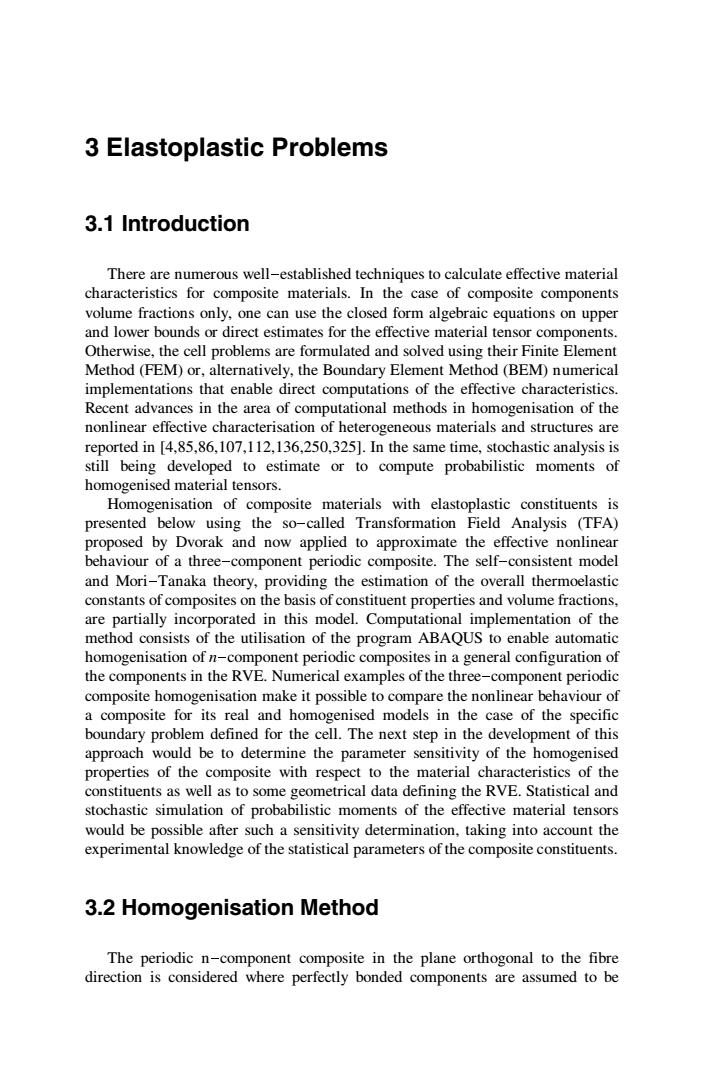正在加载图片...

3 Elastoplastic Problems 3.1 Introduction There are numerous well-established techniques to calculate effective material characteristics for composite materials.In the case of composite components volume fractions only,one can use the closed form algebraic equations on upper and lower bounds or direct estimates for the effective material tensor components. Otherwise,the cell problems are formulated and solved using their Finite Element Method(FEM)or,alternatively,the Boundary Element Method(BEM)numerical implementations that enable direct computations of the effective characteristics. Recent advances in the area of computational methods in homogenisation of the nonlinear effective characterisation of heterogeneous materials and structures are reported in [4,85,86,107,112,136,250,325].In the same time,stochastic analysis is still being developed to estimate or to compute probabilistic moments of homogenised material tensors. Homogenisation of composite materials with elastoplastic constituents is presented below using the so-called Transformation Field Analysis (TFA) proposed by Dvorak and now applied to approximate the effective nonlinear behaviour of a three-component periodic composite.The self-consistent model and Mori-Tanaka theory,providing the estimation of the overall thermoelastic constants of composites on the basis of constituent properties and volume fractions, are partially incorporated in this model.Computational implementation of the method consists of the utilisation of the program ABAQUS to enable automatic homogenisation of n-component periodic composites in a general configuration of the components in the RVE.Numerical examples of the three-component periodic composite homogenisation make it possible to compare the nonlinear behaviour of a composite for its real and homogenised models in the case of the specific boundary problem defined for the cell.The next step in the development of this approach would be to determine the parameter sensitivity of the homogenised properties of the composite with respect to the material characteristics of the constituents as well as to some geometrical data defining the RVE.Statistical and stochastic simulation of probabilistic moments of the effective material tensors would be possible after such a sensitivity determination,taking into account the experimental knowledge of the statistical parameters of the composite constituents. 3.2 Homogenisation Method The periodic n-component composite in the plane orthogonal to the fibre direction is considered where perfectly bonded components are assumed to be3 Elastoplastic Problems 3.1 Introduction There are numerous well-established techniques to calculate effective material characteristics for composite materials. In the case of composite components volume fractions only, one can use the closed form algebraic equations on upper and lower bounds or direct estimates for the effective material tensor components. Otherwise, the cell problems are formulated and solved using their Finite Element Method (FEM) or, alternatively, the Boundary Element Method (BEM) numerical implementations that enable direct computations of the effective characteristics. Recent advances in the area of computational methods in homogenisation of the nonlinear effective characterisation of heterogeneous materials and structures are reported in [4,85,86,107,112,136,250,325]. In the same time, stochastic analysis is still being developed to estimate or to compute probabilistic moments of homogenised material tensors. Homogenisation of composite materials with elastoplastic constituents is presented below using the so-called Transformation Field Analysis (TFA) proposed by Dvorak and now applied to approximate the effective nonlinear behaviour of a three-component periodic composite. The self-consistent model and Mori-Tanaka theory, providing the estimation of the overall thermoelastic constants of composites on the basis of constituent properties and volume fractions, are partially incorporated in this model. Computational implementation of the method consists of the utilisation of the program ABAQUS to enable automatic homogenisation of n-component periodic composites in a general configuration of the components in the RVE. Numerical examples of the three-component periodic composite homogenisation make it possible to compare the nonlinear behaviour of a composite for its real and homogenised models in the case of the specific boundary problem defined for the cell. The next step in the development of this approach would be to determine the parameter sensitivity of the homogenised properties of the composite with respect to the material characteristics of the constituents as well as to some geometrical data defining the RVE. Statistical and stochastic simulation of probabilistic moments of the effective material tensors would be possible after such a sensitivity determination, taking into account the experimental knowledge of the statistical parameters of the composite constituents. 3.2 Homogenisation Method The periodic n-component composite in the plane orthogonal to the fibre direction is considered where perfectly bonded components are assumed to be